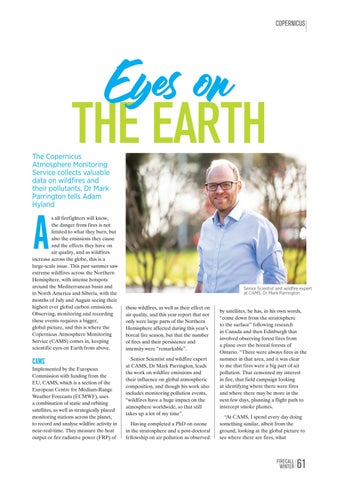COPERNICUS
Eyes on THE EARTH
The Copernicus Atmosphere Monitoring Service collects valuable data on wildfires and their pollutants, Dr Mark Parrington tells Adam Hyland
A
s all firefighters will know, the danger from fires is not limited to what they burn, but also the emissions they cause and the effects they have on air quality, and as wildfires increase across the globe, this is a large-scale issue. This past summer saw extreme wildfires across the Northern Hemisphere, with intense hotspots around the Mediterranean basin and in North America and Siberia, with the months of July and August seeing their highest ever global carbon emissions. Observing, monitoring and recording these events requires a bigger, global picture, and this is where the Copernicus Atmosphere Monitoring Service (CAMS) comes in, keeping scientific eyes on Earth from above.
CAMS
Implemented by the European Commission with funding from the EU, CAMS, which is a section of the European Centre for Medium-Range Weather Forecasts (ECMWF), uses a combination of static and orbiting satellites, as well as strategically placed monitoring stations across the planet, to record and analyse wildfire activity in near-real-time. They measure the heat output or fire radiative power (FRP) of
Senior Scientist and wildfire expert at CAMS, Dr Mark Parrington
these wildfires, as well as their effect on air quality, and this year report that not only were large parts of the Northern Hemisphere affected during this year’s boreal fire season, but that the number of fires and their persistence and intensity were “remarkable”. Senior Scientist and wildfire expert at CAMS, Dr Mark Parrington, leads the work on wildfire emissions and their influence on global atmospheric composition, and though his work also includes monitoring pollution events, “wildfires have a huge impact on the atmosphere worldwide, so that still takes up a lot of my time”. Having completed a PhD on ozone in the stratosphere and a post-doctoral fellowship on air pollution as observed
by satellites, he has, in his own words, “come down from the stratosphere to the surface” following research in Canada and then Edinburgh that involved observing forest fires from a plane over the boreal forests of Ontario. “There were always fires in the summer in that area, and it was clear to me that fires were a big part of air pollution. That cemented my interest in fire, that field campaign looking at identifying where there were fires and where there may be more in the next few days, planning a flight path to intercept smoke plumes. “At CAMS, I spend every day doing something similar, albeit from the ground, looking at the global picture to see where there are fires, what
FIRECALL WINTER
Firecall Copernicus-FINAL.indd 61
61 30/11/2021 11:35















